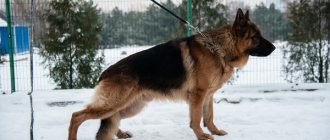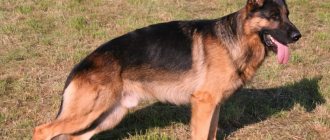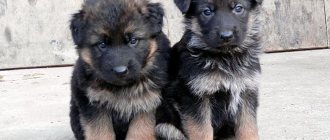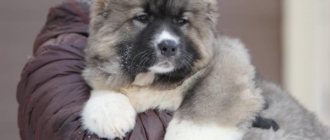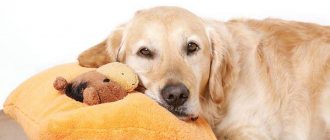The German Shepherd is a large guard breed.
It is often used to protect private territory or serve as a police officer.
These dogs have a very sharp mind, which makes them easy and quick to train.
In order for a puppy to grow into a reliable and devoted protector, you need to start raising it from the very first day of life with its new owner.
How to properly raise, care for and train?
You can learn about everything from the article.
Photo of what a German Shepherd puppy looks like at 1 month and its description
Most breeders hand over puppies on the 55th – 60th day (approximately 2 months ) from the moment of birth . The owner manages to give the brood all the necessary vaccinations, and the babies themselves get stronger and get used to independent life.
But sometimes it happens that the dog ends up in the hands of a new owner earlier, and here it is important to understand - is the pet really a representative of the declared breed, or is it just a similar mongrel?
At about 3-4 weeks, German Shepherd puppies begin to show characteristic birth differences:
- Height: from 19 to 21 cm.
- Body: short back, wide, barrel-shaped chest.
- Paws: long, thick and rather large, no dewclaw.
- Weight: from 3 to 4.2 kg (males are larger than females).
- Eyes: almond-shaped, dark brown (sometimes remain blue for up to 2 months), well convey the dog’s mood.
- Head: proportional to the body, the forehead is clearly defined, the nose is large, and a barely noticeable hump is visible on the bridge of the nose.
- Teeth: The front teeth have a scissor bite.
- Ears: soft and large, hang up to 6 months.
- Coat: hard, with a dense and dense undercoat.
When choosing a puppy, you should not rely on its color. At one month of age, the puppies' coat is black and brown, but by the time they are one year old, the color changes several times. White spots are a defect.
How to distinguish a breed from a crossbreed or mongrel
The surest way to purchase a purebred German Shepherd is to do so from a reliable kennel. Then the puppy will have a pedigree, a metric (puppy card), a brand with a unique number in the groin or on the ear. And you won’t have to guess whether you bought a purebred dog or not. When buying from private breeders or on the market, there is always a risk of making a mistake, because an amateur is unlikely to be able to correctly evaluate the breed. In this case, decide on the purpose: why you need a dog. To participate in exhibitions and breeding work, you need to look for a puppy only in nurseries with a good reputation. For official or security work - in the same place, because the character of a real German Shepherd, which made it a legend and a movie star, is also a sign of the breed. But then appearance is not so important, and the dog will cost much less.
The new owner signs the puppy inspection report (below) and the certificate is certified with a seal
If you want to have a companion dog with the appearance of a German Shepherd, then you can take the risk of purchasing it on the market or through “buy and sell” advertisements, but at the same time remember that a grown-up pet may unpleasantly surprise you with its difference from true “Germans”. There are signs by which you can try to distinguish a purebred puppy from a mestizo or mongrel:
- “Germans” have almond-shaped eyes with snow-white whites, while mongrel dogs have round, sometimes convex, eyes with yellowish whites or dark spots;
- an ordinary puppy cannot boast of a perfectly smooth topline and a body elongated like a torpedo;
- the tail of a small shepherd never rises above the line of the back and does not curl into a ring, like that of mongrels;
- The ears of a “German” should be floppy and soft for at least 4–5 months, while a mongrel’s ears may stand up at any time or not at all;
- A purebred baby does not have a stripe between the eyebrows (frontal furrow) on the forehead, but a purebred baby may have one;
- A shepherd puppy grows and develops much faster than a yard puppy, so at the same age he will weigh more and look more mature.
A “German” puppy is more inclined to communicate with a person than a mongrel puppy
Video: how to choose the right German Shepherd
Pet development at 1 - 1.5 months
Every month, German Shepherd puppies begin their growing period, which consists of several stages.:
- change of teeth;
- gradual increase in height and weight;
- socialization;
- upbringing.
A new owner should understand that in order to raise a puppy into an intelligent and well-mannered dog, it is not enough to spend on quality food and create the conditions. The animal needs human participation: education and socialization.
Reduced socialization leads to the dog becoming nervous, fearful and aggressive.
What documents should there be?
The only official document certifying the breed of a German Shepherd is its pedigree or (at first) a puppy card. These documents are issued by breeders who have permission from the RKF for breeding.
In turn, the RKF, as a member of the FCI, enters all breeding German shepherds into a common database where you can trace the origin of the dog not only at the level of its parents, but also more distant ancestors. Producers, especially in the working sector, pass standards, undergo health testing (including dysplasia), are evaluated at special breed exhibitions and receive diplomas.
Important! The test results are entered into pedigrees and reflected in the database. The authenticity of the dog is verified by its brand and chip. Any tournament or exhibition event begins with checking the number on the dog’s right ear and in its pedigree.
A serious breeder will not forget to draw up a purchase and sale agreement, which spells out in detail the responsibilities of both parties.
Return to content
Height and weight
The following table shows the physical parameters of a one-month-old shepherd puppy depending on gender:
| Gender of the animal | Height at withers | Chest circumference | Weight |
| Bitch | 19 cm | 28 cm | from 3 to 3.3 kg |
| Male | 21 cm | 31 cm | from 3.5 to 4.2 kg |
Don't be alarmed if these values fluctuate by a few centimeters or grams.
The puppy is constantly growing, and its body is fully formed by 12 months, and its indicators stabilize by 3 years of age.
Safety precautions
If a shepherd puppy grows up in a city apartment, a number of rules must be followed to protect it from injury. There are almost no differences here from other puppies or even small children:
- Wires should be hidden in special boxes or plinths.
- Strengthen or remove unstable furniture.
- Don't let him play with small, fragile toys: he will definitely break them and swallow the fragments.
- Anything that lies within his reach will be stolen and turned into a toy, so things must be put away in cabinets and drawers.
- To prevent the puppy from sharpening its teeth on all surrounding objects, it must have its own training equipment. They are sold in abundance in veterinary pharmacies - these are bones from ox veins, and scraps of rope, and cast heavy balls. You need to bring home 2-3 toys, and he will choose his favorite one.
- There should be a carpet or other similar covering on a slippery floor: the puppy’s weak paws are easily injured on a slippery floor.
- If there are children in the house, they need to be instructed how to properly handle the dog. The main thing is not to allow him to be picked up: even at three months he is quite heavy, up to 10 kg, and his paws are weak, they can easily be injured if he is accidentally dropped.
Introducing complementary foods - natural or dry food?
The first complementary foods can be introduced starting from two weeks of age, when the mother still continues to feed the puppies, but the growing organisms require more and more new “building materials”.
Natural complementary foods may consist of the following products:
- milk and curdled milk;
- minced lean beef;
- finely chopped tripe or hearts;
- hard-boiled eggs, passed through a grater;
- rice or buckwheat porridge with milk and water.
As for industrial feeds, they can be introduced into the diet no earlier than the third week.
It can be:
- dry food, soaked in warm water to a porridge-like mass;
- liquid canned food, with small pieces, especially for puppies.
Expert opinion
Tolkachev Andrey Mikhailovich
veterinarian
“Of course, ready-made food is very convenient, especially for inexperienced owners or those who spend most of their time at work. When choosing industrial feed, you should carefully study the composition. KBJU should be ideally balanced for large breed dog puppies. I recommend giving natural foods as first complementary foods - meat or dairy products."
.
Feeding with natural food
Many experienced owners devote quite a lot of time to preparing a natural diet for young animals.
IMPORTANT!
This allows you to control the nutrients and microelements entering the puppy’s body.
Advantages and disadvantages
There are both advantages and disadvantages to a natural diet.
The obvious advantages include:
- control over the quality and quantity of food consumed by the pet;
- if an allergy occurs, one component can be easily replaced with another;
- enriching the diet with natural animal protein and plant carbohydrates.
- The disadvantages of this menu are the following:
- you need to be able to create a correct and balanced diet;
- it is necessary to spend time preparing food;
- complicates the moments of traveling with a dog.
Menu
The shepherd's menu can be varied with the following dishes:
- stew from offal with cereals;
- porridge with meat broth or milk;
- peeled vegetables, raw, baked or boiled;
- boneless fish fillet (no more than twice a week);
- chicken eggs, boiled or raw (no more than twice a week);
Milk is only allowed in the diet of puppies up to 6 months . The older the dog, the more likely it is that drinking cow's milk will cause diarrhea.
How often to feed and how much to give?
In the first 2 months, puppies are fed 6 times a day, where each portion should be equal to 150 -200 grams.
Every subsequent month, the number of feedings should be reduced and the portion size increased.
Prohibited Products
Many owners often accustom the dog to their menu and feed it from the table, indulging the pet’s begging.
This is a big mistake that can lead not only to training problems, but also to serious disruptions to the gastrointestinal tract.
The following categories of products are strictly prohibited:
- fatty meats and fish;
- bones;
- all types of sausages;
- bakery;
- confectionery;
- pickled and salted vegetables;
- citrus;
- nuts and seeds;
- unboiled milk;
- dishes with a lot of spices.
Feeding dry food
By choosing industrially produced food as the basis of the diet, the owner greatly simplifies his task and saves time. But to understand whether this feeding principle is right for your pet, weigh the advantages and disadvantages.
Advantages and disadvantages
This principle of nutrition is chosen for a rather impressive list of advantages.:
- saving time on cooking;
- no need to calculate KBZHU and serving size;
- Ready-made food is convenient to take with you on the road.
However, there are some drawbacks that adherents of a natural diet tirelessly talk about.:
- there is no confidence in the naturalness of the composition and the reliability of the data indicated on the packaging;
- Incorrectly selected food can cause allergies. Without laboratory tests, it will be difficult to understand which component is the allergen;
- Cheap feeds are often made from low-grade by-products.
How to choose?
To choose a good pet food, you need to understand the existing categories.:
- Holistics. Elite food containing only natural ingredients: first-grade meat, vegetables, grains, and in some cases medicinal herbs and vitamin supplements.
- Super premium. High-quality meat, vegetables, vitamins and microelements. In the super premium class it is easy to find suitable food for a dog of any age and breed.
- Premium Premium food is made from high-quality by-products, grains and vegetables. Often you can find artificial flavor enhancers in the composition.
- Economy Consists of low-grade offal, ground tendons and a large number of grains. They have low nutritional value.
It follows from this that it is better to choose holistic or super premium food for your dog’s nutrition.
Eating dry food often leads to the formation of tartar . To prevent this, let your pet chew cartilage or special chewing sticks.
Popular manufacturers
Both veterinarians and breeders identify the following food manufacturers.
Holistics:
- Acana;
- Grandorf.
Superpremium:
- Dukes Farm;
- Eukanuba;
- Arden Grange.
How often should I feed?
Just as with natural feeding, puppies need to be fed 6 times a day.
Keep in mind that dry food causes increased thirst and make sure your pet always has clean drinking water..
First vaccinations
While the cubs are breastfed, it makes no sense to vaccinate. Their immunity is protected by their mother's antibodies. All basic vaccinations must be completed no earlier than two months.
NOTE!
If vaccination is carried out ahead of time, the puppy’s immunity will be undermined and will be unstable throughout the animal’s life.
An exception is made only if the puppies were abandoned by their mother or kept in inappropriate conditions. Then vaccination against parvovirus enteritis and distemper is done as early as possible.
For one-month-old puppies, use the drug “Nobivak pappy”.
When is weaning from the mother?
The most suitable time for weaning puppies from the bitch is 1.5-2 months of age. During this period, the psyche and character of the kids are formed, they are gradually socialized and master the main rules of behavior within the pack.
If the bitch does not have enough milk or has other problems with lactation, the puppies can be weaned earlier.
Care and education
Caring for a month-old four-legged tomboy includes the following items:
Training
A four-week-old puppy is still too young to learn complex tricks. Sometimes he can be too sloppy, spreading trash and food around the house or relieving himself right on the carpet.
This is what you should start working on.
Already at this age, commands such as “fu”, “no”, “place” and “come” can be introduced into everyday use . Use them in a playful way, do not forget to reward the puppy with treats and affection for obedience.
This will strengthen his attachment to you, and the execution of commands will be fixed in his head with pleasant associations.
Do not raise your voice and under no circumstances raise your hand to the baby. Separation from your mother at one month of age is already a lot of stress.
Excessive pressure or cruelty from a person can turn a frightened puppy into an aggressive adult whose character will be very difficult to correct.
Place for a dog
If you plan to keep a dog outside, equip in advance a spacious enclosure with an insulated booth, in which the pet can fit even when it grows up.
The roof should not leak . If you plan to keep your dog in an apartment, buy a dog bed and place it away from drafts and heating appliances.
A one-month-old puppy is still very attached to his mother, and therefore at first he may whine and call her.
Don't scold him for this - pet him, calm him down and give him a toy . This will help you strengthen the owner-dog bond.
Walk
You can teach him to relieve himself on the street immediately after all the important vaccinations have been completed.
CAREFULLY!
To begin with, 2-3 short walks of 5-10 minutes will be enough.
Gradually the time can be increased.
Water treatments
A German Shepherd needs to be washed three times a year, with the exception of winter. Immediately after bathing, dry your pet thoroughly and let him dry at home, away from drafts.
To keep the coat looking healthy, brush your dog at least once a week using a special brush with coarse bristles.
Carefully monitor the condition of your eyes - they should be clean and clear, without tearing or discharge . To prevent the development of conjunctivitis, periodically clean them with a swab soaked in chamomile infusion.
Also, don’t forget about the ears, even though they are still hanging. Once a month, wipe them with a cotton swab dipped in a special lotion.
To relieve itching during teething and at the same time protect furniture from damage - purchase special rubber toys.
Walking with a puppy
Walks are very important, especially when keeping a shepherd in an apartment.
“Going out” has several goals: walking the dog itself, playing with four-legged friends, physical activity, socialization, practicing commands, strengthening the bond between the pet and the owner.
A small puppy is often walked, but so that he does not get tired: 6-8 times for 15-20 minutes.
In general, the pet should spend at least two hours outdoors, ideally more.
The more often you have the opportunity to leave the house, the sooner the problem of cleanliness will be solved, it is important to catch the right moment: the puppy has woken up, picked him up under the belly - and outside, the same should be done after feeding and active games.
Wear a harness when walking in crowded places and a tick collar to protect it.
Every time the baby does his “tricks” outside the home, he should be actively praised.
It’s good when a dog has the opportunity to communicate with peers: during “catch-up”, the motor system is strengthened, and the skills of behavior with their own kind are improved.
Upon reaching the age of five months, you can begin training movements at the trot.
before introducing serious physical activity (running next to a cyclist, agility , towing on skis).
You should walk your growing shepherd dog everywhere, introducing him to all the city sounds, smells, objects, and inhabitants.
If you want your German Shepherd to become a true friend, treat the puppy like a new member of the family




